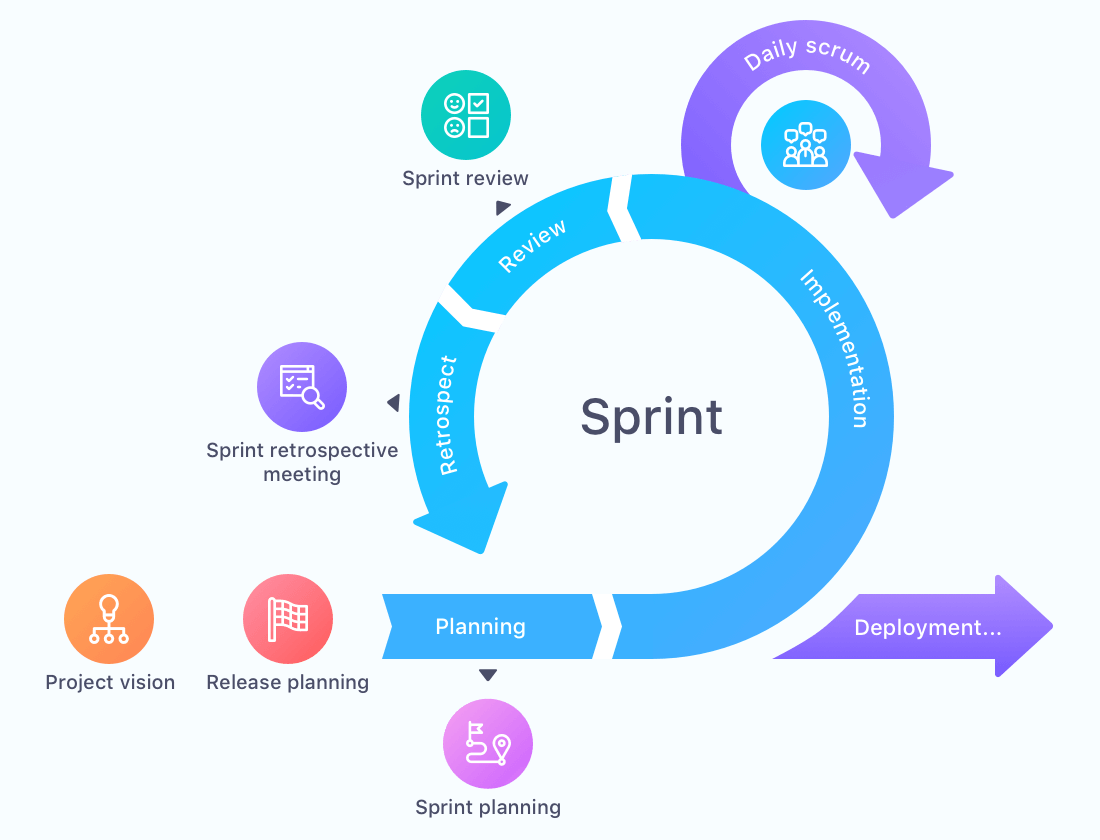With the onset of a new decade in project management and project management software, Scrum is becoming an increasingly popular Agile framework adopted by managers in charge of various projects across the world.
As a largely adaptable process that embraces transparency, flexibility, and regularly scheduled communication between all team members, Scrum is arguably one of the best project management methodologies for smaller teams who want to develop a product efficiently and deliver it promptly.
The Origins of Scrum
It all began nearly a quarter of a century ago in 1986, when the word “scrum” first appeared in the Harvard Business Review as a rugby reference, of all things. This sports parallel was made by Hirotaka Takeuchi and Ikujiro Nonaka in an effort to emphasize the importance of teamwork and strong collaboration throughout project completion.
Then, in 1993, Jeff Sutherland led a project with Scrum. Soon afterward in 1995, Sutherland and Ken Schwaber presented the process publicly, then worked with a group of other software development experts to write the Agile Manifesto in 2001 (more on Agile shortly). The first book on Scrum was published later that year.
At last, 2010 brought the Scrum Guide’s initial publication, making the facets of this methodology widely available to the public in conjunction with Scrum.org, which was launched only a single year earlier.
Between the publication of the first book about Scrum and the ultimate publication of the Scrum Guide in 2010, Sutherland and Schwaber continued to publicize the methodology by creating Scrum, Inc. and the Scrum Alliance while teaching courses on Scrum project management.
What Is Agile?
Anyone who’s heard of Scrum project management has probably also heard mentions of “Agile” in the same conversation (or even the same sentence). It makes sense, given that it was the same two figures who formalized Scrum’s process who were also responsible for publishing the 2001 Agile Manifesto.
Scrum and Agile are so linked, in fact, that it is a common misconception to think them one and the same. This is far from the case!
Scrum project management falls under the Agile approach along with other project management methodologies such as Kanban and Lean. Scrum embraces the concepts outlined in the Agile Manifesto with its own unique set of values. In other words, Scrum falls under the umbrella of Agile. It is a subset of Agile, not Agile itself.
The 3 Pillars Of Scrum
As an undefined, empirical process where actions and plans are developed according to consistent feedback and experience, Scrum maintains its value by upholding a few key principles.
The three pillars of Scrum that make this methodology what it is are:
- Transparency
- Inspection
- Adaptation
The importance of Scrum’s three pillars becomes even clearer upon learning the specifics of Scrum’s workflow. To fully understand the way Scrum operates on a daily basis, project managers will need to grasp both the three roles of the Scrum framework as well as the activities which construct this framework.
The 3 Roles of Scrum Project Management
As with any project management methodology, Scrum implements individual roles to assist with delegation, leadership, and organization amongst a collaborative team. The three roles essential to Scrum are:
1. Scrum Master
The Scrum Master is the ultimate upholder of accountability and responsibility within any scrum team, responsible for leading the team through daily workloads and serving as the lead communicator between the product owner and the development team. The scrum master also leads the daily scrum and organizes key messages to communicate with the product owner during sprint reviews and planning meetings.
2. Product Owner
One might say that the product owner is the liaison between the Scrum team and the eventual customer. The product owner has a vision for the end goals of the product and helps to direct the efforts of the scrum team in order to effectively reach these goals. The product owner also acts as a representative of sorts, keeping in close contact with stakeholders and any other entities who have a stake in the project’s success.
3. Development Team
While traditionally called a “development team,” this title may actually be a misnomer. In this case, the development team can be any kind of people, as long as they are the ones doing the work to realize a project’s end goal. They can be writers, artists, designers, construction workers, or anything else.
In short, the development team is defined as anyone who does the work. Members of this team participate in daily Scrum meetings and are held accountable for their progress. They work together to overcome challenges, and they are capable of self-organization.
This streamlined approach to role assignment keeps organization simple and the team’s primary focus on the tasks at hand. However, the simplicity of the roles in Scrum project management also means that Scrum is typically best used for small teams (seven people or less, for instance). Of course, this framework is as adaptable as any other and could be modified for more robust teams, too.
The Core Activities Of Scrum

The Scrum methodology is centered around discrete periods of time called “sprints,” in which members of a team work in short bursts to accomplish project goals in manageable chunks. A sprint may last between one and four weeks, but two weeks is the most popular duration for a sprint.
The remainder of Scrum’s core activities exist in order to surround and support the sprints.
1. Pre-Sprint Meetings
These meetings exist for team members to collectively plan their next sprint. During this gathering, contributors will discuss work that needs to be done (tasks currently existing in the backlog) and which of these tasks should receive priority for completion during the next sprint.
Importantly, these pre-sprint planning meetings also include the product owner—not just the team who will be working to develop and deliver the product during the sprint.
2. Sprint Reviews
Similarly, a meeting is held at the end of each sprint (again with the product owner), so that the team can demonstrate their progress and receive crucial feedback. This feedback will inform the following sprints and allow an opportunity for necessary adjustments.
3. Sprint Retrospective
Another post-sprint meeting called the “sprint retrospective meeting” provides team members a separate space to discuss adjustments, opportunities for improvement, and a time for general reflection on the accomplishments of the prior sprint.
The Daily Scrum
Additionally, there is a short, daily meeting called the “Daily Scrum.” These 15-minute gatherings provide further opportunity for individual team members to share their progress and plans for project contributions.
Within each daily scrum, each pillar of Scrum is upheld. Progress is regularly examined, appropriate adaptations are immediately made from the previous day’s experiences, and transparency surrounding progress is respected within the group. These discussions unify the efforts of the development team as they work toward their daily and long-term goals.
Another aspect of the Daily Scrum that makes it so successful amongst project managers is that it allows project managers and team members to recognize individual efforts. Additionally, a Daily Scrum also upholds an atmosphere of accountability which can serve to propel forward what might be an otherwise stagnant team.
Popular Tools for Scrum Project Management
Whenever there’s a project management methodology, there will be numerous technological tools to accompany it. When it comes to Scrum project management, a few tools stand above the rest as popular ways to implement Scrum’s framework into an organization’s daily functions.
The best Scrum software will include tools such as user stories, scrum boards, sprint backlogs, burndown charts, and velocity charts for use as the scrum master and development team see fit. Each of these features is designed to be shared amongst all members of a team as they organize tasks, pace themselves through sprints, and visualize their progress toward overarching project completion.
Burndown charts and velocity charts, for instance, may be developed and distributed daily by a group leader such as the scrum master so that the product owner and development team can grasp where they stand within a sea of both completed and unfinished tasks.
When implementing Scrum methodologies, you can also utilize general project management tools. A few of the most popular tools in this space include Hive, Jira, nTask, and Asana.
The Future Of Scrum
This wouldn’t be a healthy discussion of Scrum project management without some insight into the future. Will Scrum stick around? How might it evolve, just as it has since its inception almost 25 years ago?
Generally, experts believe that Agile frameworks have a successful future ahead of them.
In the end, Scrum is not a set of rigid rules, and it is designed to be adaptable to a variety of projects while meeting the diverse needs of organizations spanning multiple industries. With any such customizable framework comes a great deal of potential for further evolution and adaptation, so only the future will tell exactly how Scrum might be further utilized by new industries and how loyal users of the Scrum project management methodology will continue to adapt it.
It’s the mindset of Agile and Scrum that are important. As long as the urge for transparency, rapid adaptation, and quick-moving product delivery is desirable, Scrum will have a role in the world of project management.
Using Hive for Scrum Project Management
Hive for Scrum project management is an effective solution as it allows you to manage your projects, keep track of progress, and collaborate with your team more effectively. Hive’s Kanban board feature enables you to set up tasks and to-do lists, assign tasks to team members and collaborate with team members in real time.
Hive also provides reporting features so you can stay up to date on progress and adjust course accordingly. Hive also features roadmapping tools, so you can create and manage project goals and deadlines. Additionally, Hive features agile tools and templates that can be used to break down larger projects into small manageable tasks.






